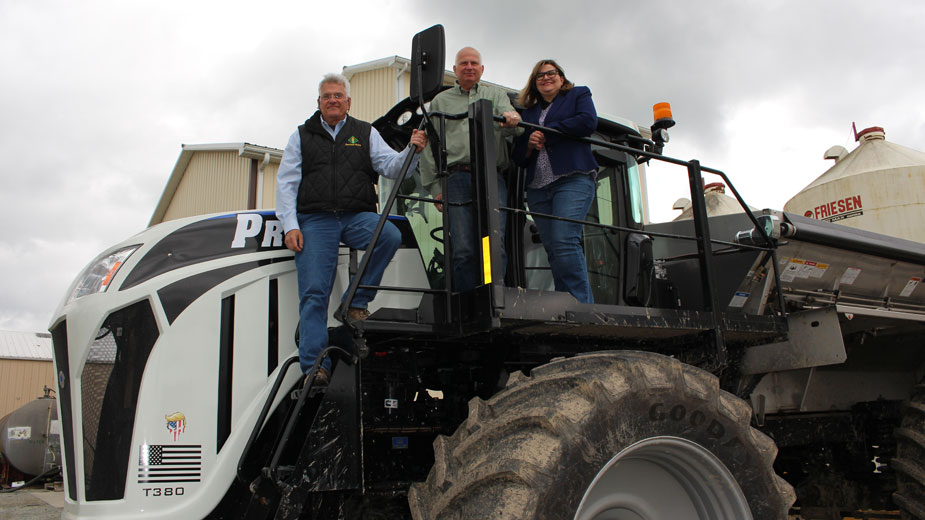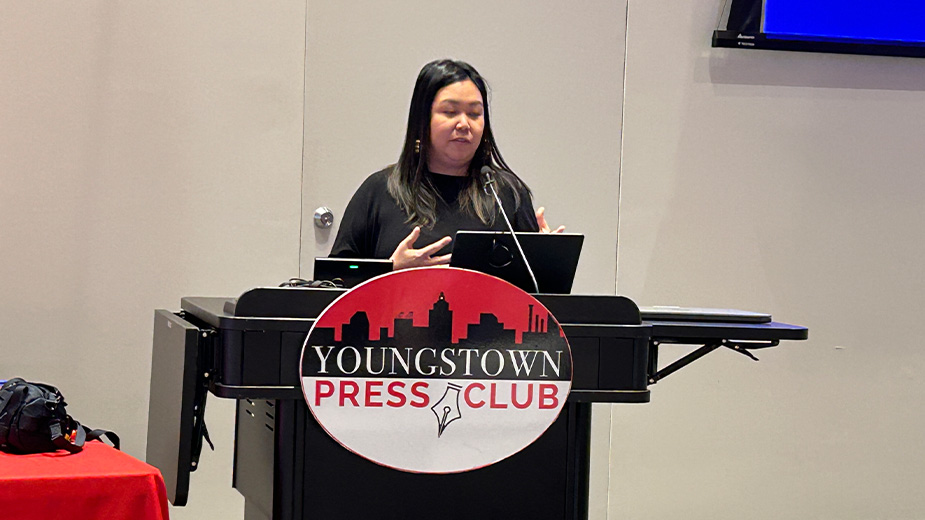Agricultural Suppliers Adapt to ‘Low Cycle’
YOUNGSTOWN, Ohio – Crop surpluses, commodity prices and a lack of oil and gas money are forcing farmers to tighten their belts, and the companies supporting them are feeling the pinch.
Deerfield Ag Services in Deerfield sees the impact on commodity prices firsthand. In addition to equipment sales, agronomy support, crop insurance and marketing for farmers, Deerfield deals with crop purchases and sales, including corn, wheat and soybeans. What it doesn’t grow on its 4,000-acre farm, it purchases from farms within a 25-mile radius and into Pennsylvania, says CEO and co-owner, Bill Wallbrown.
“Some of them are full-time farmers. Many of them are part-time farmers; they have outside farm jobs,” Wallbrown says.
Commodity prices peaked in 2012, but have since dropped significantly, with production costs being the same “or up a little bit,” Wallbrown says. Soybeans are at about $8 per bushel, down from $12. Similarly, corn dropped to $3.30 per bushel from $5 and wheat to $4 per bushel from $7, he says.
“We were flying high when the overall economy was doing poorly,” says John Wallbrown, chief operating officer. “While the overall economy is doing great right now, we’re pretty well into the low cycle.”
Corn is used primarily for ethanol production and the wheat goes to mills in Ohio and the eastern U.S. The soybeans are loaded into shipping containers on-site and exported to world markets, mostly to southeastern Asia.
To support its export business, Deerfield constructed a $4 million terminal elevator in Massillon in 2017. Rail access there allows Deerfield to load and transport grain to up to 90-car trains – some 3,400 bushels per car – and connects Deerfield to more foreign buyers, Wallbrown says.
“And ultimately, we will be able to pay the farmers more for their grain,” says Beth Padisak, co-owner.
To ensure farmers get the best possible price, Deerfield works with them to develop marketing plans and target contracts that set crop prices according to the Chicago Mercantile Exchange.
If farmers want to sell a certain number of bushels of grain at a particular price, Deerfield monitors prices throughout the trading day, says Benjamin Nething, grain originator. When the price is locked in, Deerfield advises the farmer that it’s bought the grain at the price the farmer wanted to sell.
“Prices trade 17 1/2 hours a day on the Chicago Mercantile Exchange,” Nething says. “We can’t expect our farmers to be glued to their cell phones doing nothing but watching price. It’s a way for us to try to bring dollars from outside our local economy and bring new money into our local economy.”
Leveraging the Chicago exchange allows Deerfield to offer farmers the highest possible price, adds Jenifer Pemberton, grain merchandiser. Deerfield develops profit-oriented marketing plans to help farmers set planting strategies and how much of their crop they can sell, she says.
“I pretty much have something to do everyday,” she says. “When the market’s down I’m trying to sell grain, and when the market’s up we’re trying to buy grain.”
Equipment sales at Deerfield – particularly grain elevators and storage systems – are 40% of what they were when the industry peaked in 2012, forcing the company to downsize its equipment staff, John Wallbrown says.
At the time, “there was a lot of oil and gas money in the region,” but the drilling agreements that landowners signed expired last year, some of which haven’t been renewed, Bill Wallbrown adds.
“So that free cash flow is not out there,” he says. “Farmers were spending money just so they didn’t have to pay taxes. So a lot of what we sold was from oil and gas money.”
Typically, farmers upgrade their equipment every five years, says Mike Mampieri, general manager of Ohio Ag Equipment, Broadview Heights. But the extra income from the oil contracts justified upgrading after two or three years, he says. While it’s difficult to quantify the impact it’s had on the equipment supplier’s business, he says farmers have pulled back on their spending.
“They don’t need to upgrade right now. They can hold back and run that equipment for a few more years,” Mampieri says. “Everybody’s on hold and I really understand why. If I were in their shoes, I’d probably do the same.”
To adapt, Ohio Ag invested in servicing equipment, Mampieri says. The company is hiring technicians, added a full-time technician trainer and recently purchased a property in Lima to serve as a training ground. The company also uses the property to test new equipment and technology in order to help customers maximize their yields, he says.
Ohio Ag has invested some $5 million in parts inventory across its four locations, an increase of at least $2 million, he says. It also upgraded its service trucks to perform certain tasks in the field, including changing a combine engine.
“We’re investing a ton of money in a time period that most people would probably be on reserve,” Mampieri says.
When Ohio Ag took over the equipment side of Salem-based Witmer’s Inc. in June 2017, the company focused mainly on the smaller tractors and hay tools, Mampieri says.
Since then, the company has expanded into larger equipment, which has seen increased sales, he says. Combine sales particularly are “through the roof,” up 100% over this time last year, Mampieri says.
Having a broad range of product offerings allows Ohio Ag to support farms up to 10,000 acres down to the “hobby farmers” with just a few hundred acres, he says. The company sees the most business from farms with around 3,000 acres, he says.
Ohio Ag and Witmer’s split the building at 39821 Salem-Unity Road in Salem for their operations. Since focusing on its construction business two years ago, Witmer’s has seen “tremendous growth” and is on track for a 300% increase in business over 2018, says President Nelson Witmer.
However, much of that growth is commercial construction rather than the ag work that drove business in 2017 and 2018, he says.
“So many of our ag customers are dependent on commodity prices. And with the input costs going up and depressed prices in the market, there’s not a ton of disposable income on the farms,” Witmer says.
While farms aren’t spending as much on new buildings, the company has found a niche in equine. Last year, Witmer’s and Lester Building Systems completed construction of a 10,400-square-foot indoor riding arena and 4,200-square-foot barn for Brian Cox Quarter Horses in Hubbard. The project earned first place in the National Frame Building Association’s 2017 Masters Division competition.
Witmer expects to see more projects with hobby and smaller farms, such as workshops and storage, as well as so-called “barndominiums,” he says. A barndominium is essentially a small house connected to a horse barn or workshop. Witmer’s receives one or two calls weekly about projects and has six in the pipeline.
“We’re having a real increase in interest in that market right now,” Witmer says. “It’s really phenomenal.”
For equipment, technology is playing a key role in driving purchases among customers, including precision planting and fertilizer application, autonomous vehicles and big data, says Ohio Ag’s Mampieri. As more tech is developed, it will be more affordable for the farmers with just a few hundred acres, he says. It will also alleviate labor shortages among workers.
“Hiring people who are skilled and able to operate machinery is one of the biggest challenges that farmers are facing,” Mampieri says. “There are 19 to 20 settings on combines, so you have to know what to do. When the machine can do that itself, I think that opens up more opportunities for these farms to be able to hire maybe a less skilled operator and continue to operate the farm.”
Pictured: Technology in equipment, like the fertilizer spreader shown here, allows for precision application and planting, thus improving efficiency, say second-generation co-owners of Deerfield Ag Services, Bill and John Wallbrown and Beth Padisak.
Copyright 2024 The Business Journal, Youngstown, Ohio.



